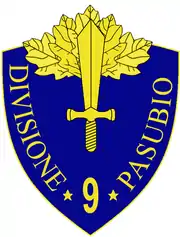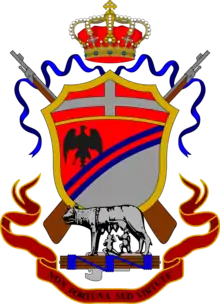9th Infantry Division Pasubio
The 9th Infantry Division Pasubio was an auto-transportable binary-type (2-regiments) Infantry[nb 1] Division of the Italian Army during World War II. The division was formed as an infantry division in 1934, reorganized into an infantry division in 1939 and mobilized in August 1940. Its 79th Infantry Regiment and 8th Artillery Regiment were made up of men from Verona, while the ranks of the 80th Regiment were filled with men from Mantua. Its 1st Sabauda CCNN Battalion was made up of volunteers from Turin.
| 9th Infantry Division Pasubio | |
|---|---|
 9th Infantry Division Pasubio Insignia | |
| Active | 1934–1943 |
| Country | Kingdom of Italy |
| Branch | Royal Italian Army |
| Type | Infantry |
| Role | Infantry |
| Size | Division |
| Part of | Italian Expeditionary Corps in Russia 8th Army |
| Garrison/HQ | Verona |
| Nickname(s) | Pasubio |
| Engagements | World War II Invasion of Yugoslavia Eastern Front Assault on Stalino Battle of Nikolayevka |
| Insignia | |
| Identification symbol |  |
| Identification symbol | Pasubio Division collar insignia |
Action
The Pasubio Division took part in the Invasion of Yugoslavia in April 1941. First it was deployed at San Pietro del Carso dam (near modern Pivka). By 16 April, Pasubio division has overcome border defenses and reached the road to Otocac.[1] Closer to the end of war, it reached Šibenik-Split region where it participated in mop-up operations until 28 May 1941. After the end of the military operation in Yugoslavia, Pasubio division was returned to Verona.
Assigned to the Russian expedition corps (or Corpo di Spedizione Italiano in Russia (CSIR)) in the beginning of July 1941, Pasubio division has left Verona 10 July 1941 and reached Yampil on Dniester river at 6 August 1941. The first contact with the Soviet army happened 10 August 1941 near town of Voznesensk on Southern Bug river. The Polyana village was reached by 12 August 1941. From 18 September 1941 until 26 September 1941 the "Pasubio" participated in the Battle of Kiev (1941), capturing and holding a bridgehead on the eastern side of Dnieper river. In October 1941, the Pasubio division has advanced by route Petrikovka-Dnipropetrovsk-Pavlohgrad-Ulyanivka(Kharkiv Oblast)-Izium. The Pasubio played a significant role in the capture of Donetsk(Stalino) in October 1941, earning the praise of the German First Panzer Group's commander, General Ewald von Kleist.[2] 1 November 1941, the Pasubio division has attacked Horlivka town and captured it after fierce fighting. Village Nikitovka north of Horlivka fell soon thanks to rapid Italian action. The Pasubio division also contributed significantly to the capture of the Shazopetovka and Bulavyns'ke to the east of Horlivka. By that time, the Soviets forces increased to an extent where the Pasubio Division has switched to defense.
In January 1942 the Pasubio division has helped German troops fighting in Izium area, where it fends off a heavy Soviet attack near village of Novaya Orlovka. By July 1942, Pasubio division was fighting near town of Krasnyi Luch. In August, it reached Don River (Russia), where the right flank of Pasubio Division was heavily attacked by Soviet forces 20 August 1942. The attack was repelled in a few days, and position warfare was established until 11 December 1942, when the Soviets attacked again with a large number of tanks. 16 December 1942 the Pasubio Division has counterattacked and returned to the initial position. But by that time general front-line collapse was already underway. Nearby 52nd Infantry Division Torino and 2nd Mountain Infantry Division Sforzesca has failed to maintain their positions, therefore Pasubio Division was forced to retreat to avoid encirclement. After a few days of retreat, Pasubio Division was no longer able to maintain a front-line, instead covering only roads. 25 December 1942, a rearguard of 600 men was surrounded in the village of Krasnoyarovka in Rostov Oblast and annihilated by 28 December 1942. The main body of Pasubio division had barricaded in the northern part of Chertkovo village together with shattered remnants of various German units, and repelled several attacks starting from 23 December 1942. A grueling march to first avoid, and then to break the encirclement, has continued. 15 January 1943 the fight to break through the Soviet lines has started. Finally, 2000 men remaining of Pasubio division had broken the encirclement 17 January 1943 near the town of Belovodsk, Luhansk oblast.
The people from Pasubio division had marched to Donetsk by end of January 1943 and boarded trains back to Italy. The survivors had returned home in April 1943 – to be transferred to Province of Caserta for the duties of coastal defense. The garrisons locations were villages Avena, Grazzanise, Sparanise, and town Santa Maria Capua Vetere. The garrisons were mostly captured by the Germans in the aftermath of the Armistice of Cassibile (surrender of Italy to Allies) 8 September 1943.[3][4]
Order of battle

- 79th Infantry Regiment "Roma"
- 79th Command Company
- 1stInfantry Battalion
- 2ndInfantry Battalion
- 3rdInfantry Battalion
- 87th Mortar Company with 81mm Mortars
- 87th Support Arms Company with 65/17 Field Guns
- 80th Infantry Regiment "Roma"
- 80th Command Company
- 4thInfantry Battalion
- 5thInfantry Battalion
- 6thInfantry Battalion
- 87th Mortar Company with 81mm Mortars
- 87th Support Arms Company with 65/17 Field Guns
- 8th Artillery Regiment "Pasubio"
- 1st Artillery Group with 100/17 Field Cannons
- 2nd Artillery Group with 75/27 Field Cannons
- 3rd Artillery Group with 75/27 Field Cannons
- 85th Anti-Aircraft Battery with 20mm Anti-Aircraft Guns
- 309th Anti-Aircraft Battery with 20mm Anti-Aircraft Guns
- 1st CCNN Legion (Blackshirts)
- 1st CCNN Battalion "Sabauda"
- CCNN Battalion
- 5th Mortar Battalion with 81mm Mortars
- 9th Mortar Battalion with 81mm Mortars
- 9th Anti-Tank Company with 47/32 Anti-Tank Guns
- 141st Anti-Tank Company with 47/32 Anti-Tank Guns
- 30th Pioneer Company
- 9th Signal Company
- 5th Medical Section
- 25th Surgical Unit
- 825th Field Hospital
- 826th Field Hospital
- 836th Field Hospital
- 874th Field Hospital
- 25th Motorized Carabinieri Section
- 26th Motorized Carabinieri Section
- 95th Searchlight Section
- 11th Supply Section
- 26th Field Bakery
- 91st Fuel Section
- 8th Traffic Control Unit
- 9th Maintenance Unit
- 9th Automobiles Platoon
- 83rd Field Post Office
Notes
- Footnotes
- The division never had the required amount of Motor Transport to move all its units at the same time and is referred to as a Auto-transportable Division
- An Italian Infantry Division normally consisted of two Infantry Regiments (three Battalions each), an Artillery Regiment, a Mortar Battalion (two companies), an Anti Tank Company, a Blackshirt Legion (Regiment of two Battalions). Each Division had only about 7,000 men. The Infantry and Artillery Regiments contained 1,650 men, the Blackshirt Legion 1,200, each company 150 men.[5]
- Citations
- http://www.regioesercito.it/reparti/fanteria/rediv9.htm
- "Pasubio earned von Schobert's praise during the battles between the Dniestr and Bug rivers." Operation Barbarossa: The German Invasion of Soviet Russia, Robert Kirchubel, p. 220, Osprey Publishing, 2013
- Wendal, Marcus. "Italian Army". Axis History. Retrieved 4 October 2009.
- "The Axis". The Canadian Soldier. Retrieved 4 October 2009.
- Paoletti, p 170